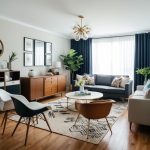Transform Your Bedroom into a Relaxing Retreat: Tips from Experts
Personalizing Your Space with Art and Photographs
Adding art and photographs to your bedroom can make the space uniquely yours. These elements can reflect your personal style and create an environment that feels inviting and comforting.
Curating a Gallery Wall
Creating a gallery wall is an effective way to display multiple pieces of art. Start by selecting a color scheme or theme that matches your bedroom’s decor. Combine different sizes and shapes of frames to add visual interest.
Mixing photographs, paintings, and prints can make the arrangement dynamic. Lay out your chosen pieces on the floor before hanging them to get a sense of the overall layout. Ensure that the arrangement feels balanced and cohesive.
Spacing between frames is crucial. Aim for consistent spacing to achieve a harmonious look. Use a level to ensure that each piece is hung straight. Consider incorporating mirrors or other decorative elements for added texture.
Framing and Placement Tips
Choose frames that complement your artwork and bedroom decor. Simple frames in neutral colors can enhance the art without overwhelming it. For a cohesive look, you might select frames with similar styles or materials.
When placing art and photographs, consider the height at which they are displayed. Eye level is often recommended, typically about 57-60 inches from the floor. When hanging above furniture, maintain a gap of 6-12 inches between the top of the furniture and the bottom of the frame.
Lighting can greatly affect how art is perceived. Use soft, ambient lighting to prevent glare on framed works. Picture lights or spotlights can highlight key pieces, adding sophistication to the space.
Experiment with different arrangements and placements to find what feels most harmonious in your bedroom.
Incorporating Texture for Comfort and Depth
Adding texture through elements like rugs, throws, and soft furnishings can enhance the comfort and depth of a bedroom. Each of these details plays a crucial role in creating a space that feels cozy and inviting.
Layering Rugs and Throws
Layering different rugs or pairing a rug with a throw can add significant depth to a bedroom. He or she might start by placing a larger rug as the base, then adding a smaller, patterned rug on top. This creates visual interest and makes the space feel more expansive.
Throws can be draped over the bed or a chair. Using varied textures like chunky knits or smooth velvets can bring warmth and softness. The key is to mix and match materials that complement the overall decor while providing comfort.
Choosing Soft Furnishings
Selecting the right soft furnishings is essential for comfort and style. He or she should focus on bedding, pillows, and curtains made from materials like cotton, linen, or silk. These fabrics feel luxurious and are also breathable, contributing to a restful night’s sleep.
Cushions and pillows in different shapes and sizes can add a dynamic touch. Mixing textures like embroidered patterns, smooth fabrics, and woven details can create a rich and inviting atmosphere. The alignment of colors and textures should evoke a sense of relaxation and harmony in the space.
Managing Clutter with Smart Storage Solutions
Creating a clutter-free bedroom starts with implementing intelligent storage. This includes innovative hidden storage options and the use of decorative baskets and boxes to keep essentials organized and out of sight.
Hidden Storage Hacks
Utilize the space under the bed by opting for storage bins or drawers that slide easily. This area is perfect for stowing away off-season clothing, extra bedding, or shoes. Beds with built-in storage compartments combine functionality and design, making them a great investment.
Floating shelves offer another discreet storage solution. They can be used to display decorative items while keeping everyday essentials within reach. Shelves above doors utilize often-overlooked space, providing a practical way to store less frequently used items.
Ottomans with built-in storage are both stylish and practical. They can hold blankets, magazines, or even kids’ toys, while also serving as extra seating or a footrest. Consider multifunctional furniture to maximize storage efficiency.
Decorative Baskets and Boxes
Decorative baskets and boxes not only add charm to your bedroom but also enhance organization. Position wicker baskets at the foot of the bed for extra blankets or pillows. These containers can seamlessly fit into the room’s decor while offering a practical solution.
For smaller items, use aesthetically pleasing boxes on dressers or shelves. They can hold jewelry, stationery, or small gadgets, keeping surfaces tidy and uncluttered. Labels on these boxes can further enhance organization by clearly indicating their contents.
Place sturdy baskets inside the closet for sorting laundry or storing accessories like scarves and belts. Color-coordinated baskets contribute to a cohesive look, making the space feel more organized and visually appealing.



